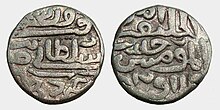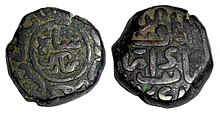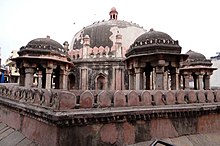Sayyid dynasty
Sayyid dynasty Delhi Sultanate | |||||||||||
|---|---|---|---|---|---|---|---|---|---|---|---|
| 1414–1451 | |||||||||||
Territories of the Sayyid Dynasty, and main contemporary South Asian polities.[1] | |||||||||||
| Capital | Delhi | ||||||||||
| Common languages | Persian(official)[2] | ||||||||||
| Religion | Sunni Islam[3] | ||||||||||
| Government | Monarchy | ||||||||||
| Sultan | |||||||||||
• 1414–1421 | Khizr Khan Sayyid | ||||||||||
• 1421–1434 | Mubarak Shah | ||||||||||
• 1434–1443 | Muhammad Shah | ||||||||||
• 1443–1451 | Ala-ud-Din Shah | ||||||||||
| History | |||||||||||
• Established | 28 May 1414 | ||||||||||
• Disestablished | 20 April 1451 | ||||||||||
| |||||||||||
| Today part of | |||||||||||
TheSayyid dynastywas the fourth dynasty of theDelhi Sultanate,with four rulers ruling from 1414 to 1451 for 37 years.[4]The first ruler of the dynasty,Khizr Khan,who was theTimuridvassal ofMultan,conquered Delhi in 1414, while the rulers proclaimed themselves the Sultans of theDelhi SultanateunderMubarak Shah,[5][6]which succeeded theTughlaq dynastyand ruled the Sultanate until they were displaced by theLodi dynastyin 1451.
Origins[edit]
A contemporary writerYahya Sirhindimentions in hisTarikh-i-Mubarak Shahithat Khizr Khan was a descendant ofMuhammad.[7]Members of the dynasty derived their title,Sayyid,or the descendants of the Islamic prophet Muhammad, based on the claim that they belonged to his lineage through his daughterFatima.However, Yahya Sirhindi based his conclusions on unsubstantial evidence, the first being a casual recognition by the famous saint Sayyid Jalaluddin Bukhari of Uch Sharif of his Sayyid heritage in the household of his adoptive grandfather Malik Mardan Daulat who is also referred to as Malik Mardan Bhatti by Yahya,[8][9][10]and the second being the Sultan's noble character which distinguished him as possessing the moral qualities of Muhammad's descendant.[11]Abraham Eralyis of the opinion that Khizr Khan's ancestors were likely descendants of an Arab family who had long ago settled in the region of Multan during the early Tughluq period, but he doubts his Sayyid lineage.[12]According toRichard M. Eatonand oriental scholarSimon Digby,Khizr Khan was aPunjabichieftain belonging to theKhokharclan, who was sent to Timur as an ambassador and negotiator from the most adjacent area, the Punjab, ultimately becoming the power holder in Delhi, thanks to the contacts he had acquired.[13][14]
History[edit]

Khizr Khan was originally a noble in the Delhi Sultanate during theTughlaq Dynastyand was the governor of Multan under SultanFiruz Shah.He was expelled from the city by the Muin tribes under Sarang Khan who occupied Multan in 1395,[15][16]an Indian Muslim and the brother of Mallu Iqbal Khan, who was the de-facto ruler of Delhi.[17][18][19][20]Sarang Khan was aided by the servants of Malik Mardan Bhatti, a former governor of Multan and the grandfather of Khizr Khan by adoption.[21][22]
Following Timur's 1398Sack of Delhi,[23]he appointedKhizr Khanas deputy ofMultan(Punjab).[24]He held Lahore, Dipalpur, Multan and Upper Sindh.[25][26]Collecting his forces in Multan, Khizr Khan defeated and killed Mallu Iqbal Khan in Delhi in 1405.[27]He then captured Delhi on 28 May 1414 thereby establishing the Sayyid dynasty.[24]Khizr Khan did not take up the title ofSultan,but continued the fiction of his allegiance to Timur asRayat-i-Ala(vassal) of theTimurids- initially that of Timur, and later his sonShah Rukh.[28][29]After the accession of Khizr Khan, the Punjab,Uttar Pradeshand Sindh were reunited under the Delhi Sultanate, where he spent his time subduing rebellions.[30]
Khizr Khan was succeeded by his son SayyidMubarak Shahafter his death on 20 May 1421. Mubarak Shah referred to himself asMuizz-ud-Din Mubarak Shahon his coins, removing the Timurid name with the name of the Caliph, and declared himself a Shah.[31][32]A detailed account of his reign is available in theTarikh-i-Mubarak Shahiwritten byYahya-bin-Ahmad Sirhindi.After the death of Mubarak Shah, his nephew,Muhammad Shahascended the throne and styled himself as Sultan Muhammad Shah. Just before his death, he called his son SayyidAla-ud-Din ShahfromBadaun,and nominated him as successor.[citation needed]
The last ruler of the Sayyids,Ala-ud-Din,voluntarily abdicated the throne of the Delhi Sultanate in favour ofBahlul Khan Lodion 19 April 1451, and left for Badaun, where he died in 1478.[33]
Kings[edit]
Khizr Khan[edit]

Khizr Khanwas the governor of Multan underFiruz Shah Tughlaq.WhenTimurinvaded India, Khizr Khan, a Sayyid fromMultanjoined him. Timur appointed him the governor of Multan and Lahore. He then conquered the city of Delhi and started the rule of the Sayyids in 1414. He was ruling in the name of Timur. He could not assume an independent position in all respects. As a mark of recognition of the suzerainty of the Timurids, the name of the Timurid ruler (Shah Rukh) was recited in the khutba but as an interesting innovation, the name of Khizr Khan was also attached to it. But strangely enough, the name of the Timurid ruler was not inscribed on the coins and the name of the old Tughlaq sultan continued on the currency. No coins are known in the name of Khizr Khan.[34]
Mubarak Shah[edit]

Mubarak Shahwas the son of Khizr Khan, who ascended the throne in the year 1421. Mubarak Shah discontinued his father's nominal allegiance to Timur.[35]He freely used the royal title of Shah along with his own name, and professed allegiance to theKhalifahalone.[36]He was the ablest ruler of the Sayyid dynasty.[37]He defeated the advancingHoshang Shah Ghori,the ruler of theMalwa Sultanateand forced him to pay heavy tribute early in his reign.[38]Mubarak Shah also put down the rebellion ofJasrath Khokharand managed to fend off multiple invasions by the Timurids of Kabul.[39]
Muhammad Shah[edit]

Muhammad Shahwas a nephew of Mubarak Shah. He ruled from 1434 to 1443. Muhammad Shah acceded to the throne with the help of Sarwar ul Mulk. After that Shah wanted to free himself from the domination of Sarwar ul Mulk with the help of his faithful vizier Kamal ul Mulk. His reign was marked by many rebellions and conspiracies, and he died in the year 1445. Multan became independent under the Langahs during his rule.[40]
Alam Shah[edit]
The last ruler of the Sayyid dynasty, Alauddin Alam Shah was defeated by Bahlol Lodi, who started theLodi dynasty.
See also[edit]
| Delhi Sultanate |
|---|
| Ruling dynasties |
References[edit]
- ^Schwartzberg, Joseph E. (1978).A Historical atlas of South Asia.Chicago: University of Chicago Press. p. 39, 148.ISBN0226742210.
- ^"Arabic and Persian Epigraphical Studies – Archaeological Survey of India".Asi.nic.in.Retrieved14 November2010.
- ^V. D. Mahajan (2007).History of Medieval India.ISBN9788121903646.
- ^See:
- M. Reza Pirbha, Reconsidering Islam in a South Asian Context,ISBN978-9004177581,Brill
- The Islamic frontier in the east: Expansion into South Asia, Journal of South Asian Studies, 4(1), pp. 91–109
- Sookoohy M., Bhadreswar – Oldest Islamic Monuments in India,ISBN978-9004083417,Brill Academic; see discussion of earliest raids in Gujarat
- ^V. D. Mahajan (2007).History of Medieval India.ISBN9788121903646.
- ^Iqtidar Alam Khan (2008).Historical Dictionary of Medieval India.p. 103.ISBN9780810855038.
- ^Porter, Yves; Degeorge, Gérard (2009).The Glory of the Sultans: Islamic Architecture in India.Flammarion.ISBN978-2-08-030110-9.
Though Timur had since withdrawn his forces, the Sayyid Khizr Khān, the scion of a venerable Arab family who had settled in Multān, continued to pay him tribute.
- ^The Cambridge History of India: Turks and Afghans, edited by W. Haig.S. Chand. 1958.
The claim of Khizr Khān, who founded the dynasty known as the Sayyids, to descent from the prophet of Arabia was dubious, and rested chiefly on its causal recognition by the famous saint Sayyid Jalāl-ud-dīn of Bukhārā.
- ^Journal of Sikh Studies:Volume 20.Department of Guru Nanak Studies. 1996. p. 61.
- ^Beveridge, Henry (1992).Tarikh-I-Mubarakshahi.Rima Publishing House. p. 168.
- ^Ramesh Chandra Majumdar (1951).The History and Culture of the Indian People: The Delhi sultanate.Bharatiya Vidya Bhavan.
- ^Eraly, Abraham (1 April 2015).The Age of Wrath: A History of the Delhi Sultanate.Penguin UK. p. 261.ISBN978-93-5118-658-8.
The first of these two dynasties was founded by Khizr Khan, who bore the appellation 'Sayyid', which identified him as a descendant of prophet Muhammad, so the dynasty he founded came to be known as the Sayyid dynasty. The veracity of Khizr Khan's claimed lineage is uncertain, but it is likely that his forebears were Arabs, who had migrated to India in the early Tughluq period and settled in Multan. The family prospered in India, gaining wealth and power. This advancement culminated in Malik Suleiman, Khizr Khan's father, becoming the governor of Multan under the Tughluqs. When Suleiman died, Khizr Khan succeeded him to the post, but lost it during the political turmoil following the death of Firuz Tughluq.
- ^Eaton, Richard M.(2019).India in the Persianate Age: 1000–1765.University of California Press.p. 105.ISBN978-0520325128.
The career of Khizr Khan, a Punjabi chieftain belonging to the Khokar clan, illustrates the transition to an increasingly polycentric north India.
- ^Digby, Simon(2014)."After Timur Left: North India in the Fifteenth Century".InOrsini, Francesca;Sheikh, Samira (eds.).After Timur Left: Culture and Circulation in Fifteenth-century North India.Oxford University Press. pp. 47–59.doi:10.1093/acprof:oso/9780199450664.003.0002.ISBN978-0-19-945066-4.
—and we find that a Khokar chieftain, Khizr Khan, who was sent to Timur as an ambassador and negotiator for tribute from the most adjacent area, the Punjab, ultimately became the power-holder in Delhi, thanks to the contacts he had acquired.
- ^Surender Singh (2019).The Making of Medieval Panjab Politics, Society and Culture C. 1000–c. 1500.
- ^Raj Kumar (2008).Encyclopaedia Of Untouchables: Ancient Medieval And Modern.p. 280.
accompanied by the Bhatti and Main crossed the Sutlej
- ^M. A. Khan (2009).Islamic Jihad: A Legacy of Forced Conversion, Imperialism, and Slavery.
Indian-origin slave-soldiers (converted Muslims) such as Malik Kafur, Malik Naik, Sarang Khan, Bahadur Nahar, Shaikha Khokhar, and Mallu Khans
- ^John F. Richards; David Gilmartin; Munis D. Faruqui; Richard M. Eaton; Sunil Kuma.Expanding Frontiers in South Asian and World History: Essays in Honour of John F. Richards.p. 247.
Mallu Khan(also known as Iqbal Khan, a former slave
- ^Journal of Indian History - Volume 55.Department of Modern Indian History. 1977. p. 105.
Indian Musalmans like Malik Kafur, Khusrau Khan and Khan - i - Jahan Maqbul reached close to the throne, and men like Mallu Khan, Sarang Khan, Muqarrab Khan etc
- ^V. D. Mahajan (2007).History of Medieval India.p. 221.
The result of this was that Nasir-ud-Din Mahmud Shah became a tool in the hands of Mallu Iqbal
- ^Singh, Surinder (30 September 2019).The Making of Medieval Panjab: Politics, Society and Culture c. 1000–c. 1500.Routledge.ISBN978-1-000-76068-2.
- ^Elliot, Sir Henry Miers (1952).The History of India, as Told by Its Own Historians. The Muhammadan Period: The Posthumous Papers of H. M. Elliot.S. Gupta (India). p. 118.
- ^Jackson 2003,p. 103.
- ^abKumar 2020,p. 583.
- ^Kenneth Pletcher (2010).The History of India.p. 138.ISBN9781615301225.
- ^V. D. Mahajan (2007).History of Medieval India.p. 229.ISBN9788121903646.
- ^Jaswant Lal Mehta (1979).Advanced Study in the History of Medieval India: Volume 2.p. 247.
- ^Proceedings:Volume 55.Indian History Congress. 1995. p. 216.
- ^Mahajan, V.D. (1991, reprint 2007).History of Medieval India,Part I, New Delhi: S. Chand,ISBN81-219-0364-5,p.237
- ^Rajasthan [district Gazetteers] Bharatpur.Printed at Government Central Press. 1971. p. 52.
- ^V. D. Mahajan (2007).History of Medieval India.ISBN9788121903646.
- ^Iqtidar Alam Khan (2008).Historical Dictionary of Medieval India.p. 103.ISBN9780810855038.
- ^Mahajan, V.D. (1991, reprint 2007).History of Medieval India,Part I, Now Delhi: S. Chand,ISBN81-219-0364-5,p.244
- ^Nizami, K.A. (1970, reprint 2006)A Comprehensive History of India,Vol-V, Part-1, People Publishing House,ISBN81-7007-158-5,p.631
- ^Journal: Issues 1-3.Aligarh Historical Research Institute. 1941. p. 73.
- ^V. D. Mahajan (2007).History of Medieval India.p. 239.
- ^Arihant Experts (2021).CTET and TET Social Science and Pedagogy for Class 6 to 8 for 2021 Exams.p. 43.
- ^Lal, Kishori Saran (1980).Twilight of the Sultanate: A Political, Social and Cultural History of the Sultanate of Delhi from the Invasion of Timur to the Conquest of Babur 1398-1526.Munshiram Manoharlal.ISBN978-81-215-0227-6.
Hoshang tried his luck against Sultan of Delhi but he was beaten back by Mubarak Shah Saiyyad to whom he had to pay a handsome tribute
- ^Lal, Kishori Saran (1980).Twilight of the Sultanate: A Political, Social and Cultural History of the Sultanate of Delhi from the Invasion of Timur to the Conquest of Babur 1398-1526.Munshiram Manoharlal. p. 109.ISBN978-81-215-0227-6.
- ^Masudul Hasan, Abdul Waheed.Outline History of the Islamic World.the University of Michigan. p. 1974.
Sources[edit]
- Kumar, Sunil (2020). "The Delhi Sultanate as Empire". In Bang, Peter Fibiger; Bayly, C. A.; Scheidel, Walter (eds.).The Oxford World History of Empire.Vol. 2. Oxford University Press.
- Jackson, Peter (2003).The Delhi Sultanate: A Political and Military History.Cambridge University Press.


